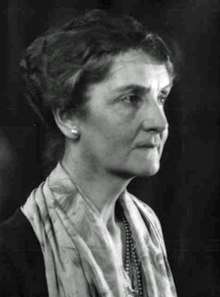Clara Hagarty
Clara Sophia Hagarty (1871–1958) was a Canadian artist.
Clara Sophia Hagarty | |
|---|---|
 | |
| Born | 1871 Toronto, Ontario, Canada |
| Died | 1958 (aged 86–87) Toronto, Ontario, Canada |
| Nationality | Canadian |
| Known for | Floral painting |
| Elected | Royal Canadian Academy of Arts (1904) |
Born in Toronto, Hagarty worked with paints and pastels.[1] She is best known for her paintings of flowers.[2] She was elected to the Ontario Society of Artists in 1903 Royal Canadian Academy of Arts in 1904. She studied in New Jersey, Paris, and the Netherlands. She spent World War I working for the Red Cross in London, and after the war worked at the Art Gallery of Toronto until 1928.[2] She died in Toronto, Ontario in 1958.[2]
Childhood
Her childhood was enjoyable. As the granddaughter of Sir John Hawkins Hagarty, a former Chief Justice of Ontario, she spent time at the family's "little English Mansion," amongst beautiful elm trees and grass lawns where she played plenty of tennis.[3]
Education
Clara Hagarty began her art education in Toronto under Sydney Strickland Tully and Edmund Wyly Grier.[4] Following her studies in Toronto, Hagarty joined sketching classes at the Chase School, now known as Parsons The New School for Design in New York.[4] Hagarty then travelled to Europe; studying in France, Italy, and the Netherlands.[4] While in Paris, Hagarty was the student of Frederick William MacMonnies and Claudio Castelucho.[4]
Early works
Clara Hagarty's early works tended to focus on portraits and interiors.[3] A number of these works were exhibited at the Pan-American Exposition in Buffalo in 1901.[3]
Exhibitions
Hagarty's pastel work and sketches in Italy, the Dolomites and Scotland were on exhibition at the T. Eaton Fine Art Galleries in Toronto.[3] Her work was described as having a "lovely delicacy" and her skill with the "gradation of color" was noted.[3] Works present, at the time, include: St. Peter's, Sunset, "Clover Fields, Cortina", The Alhambra, Spring, "Wisteria, Varenna", "A Bridge", "Field Flowers, Cortina", "Cypress Trees and Olives", and "Edinburgh Mist".[3] Hagarty had approximately 85 sketches present.[3] The pieces were inspired by Hagarty's trips to Europe between 1921 and 1925.[3] Haggarty explained that her choice of pastels was because she perceived them to be cleaner than paints.[3]
After returning from the Red Cross and taking up work at the Art Gallery of Toronto, Hagarty held a retrospective exhibition of her work in 1951.[5] Hagarty produced less art as her sight began to deteriorate.[5] In this exhibit she showed works that had never been seen before; such as oil paintings of Paris and the French countryside.[5]
References
- "Clara S. Hagarty". Galerie Q. Archived from the original on 2015-03-09. Retrieved 2015-03-07.
- "Hagarty, Clara Sophia". Canadian Women Artists History Initiative. Concordia. 2012.
- Saturdav Night, Toronto, October 29, 1928 "Clara S. Hagarty, A.R.C.A., O.S.A., - and Her Exhibition of Lovely Flower Pieces and Italian Scenes" by Hilda Ridley
- Hagarty, Clara, Information File, E.P. Taylor Research Library
- Globe and Mail, Clara Hagarty Shows Career in Retrospect, Toronto, September 29, 1951